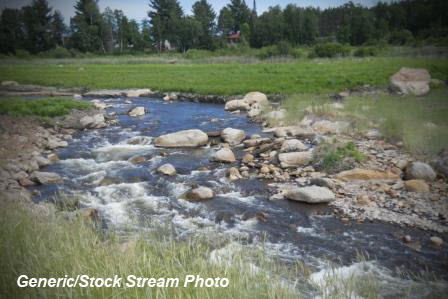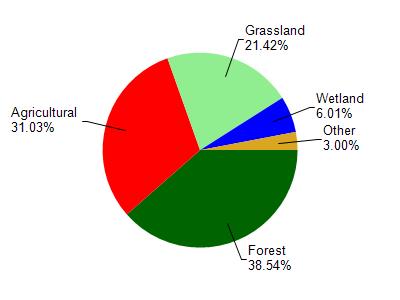
5.37 Miles
0 - 5.37
Cool-Cold Headwater
2015
Poor
Elevated Water Temperature
Sediment/Total Suspended Solids
Trempealeau
No
No
Yes
Fish and Aquatic Life
Overview
Welch Coulee Creek - The full 4.5-mile length of Welch Coulee Creek is listed as
impaired on the 303(d) list. Welch Coulee Creek is listed as impacted by elevated
temperature, loss of instream habitat, and sedimentation, primarily due to stream bank
erosion. In a 1990 survey (1), the stream HBI was 3.20 indicating no apparent organic
loading, and the Habitat Rating was "fair". The stream is currently a Warm Water Forage
Fishery. The potential use is coldwater Class III.
Date 2002
Author Aquatic Biologist
General Condition
Water resource problems include sedimentation of riffles and pools and scarcity of stable instream cover. Primary sources of the sediment reaching the impaired streams include stream bank erosion from a combination of cattle grazing of stream banks and upland erosion, primarily from crop fields and other agricultural lands. A frequent consequence of erosion and subsequent sediment delivery is sedimentation of pools, filling-in of spawning substrate in riffle area. The filling-in of riffle areas reduces the reproductive success of trout by reducing inter-gravel flow, which is necessary to maintain suitable temperature & oxygen conditions for eggs and fry. Sedimentation of riffle areas also reduces suitable habitat for macroinvertebrates and other sources of food for fish. Filling in of pools reduces the amount of available cover for juvenile and adult fish.
Date 2013
Author Aquatic Biologist
Impaired Waters
TMDL has been approved 2003. The full 4.5-mile length of Welch Coulee Creek is listed as impaired on the 303(d) list. Welch Coulee Creek is listed as impacted by elevated temperature, loss of instream habitat, and sedimentation, primarily due to stream bank erosion. In a 1990 survey (1), the stream HBI was 3.20 indicating no apparent organic loading, and the Habitat Rating was "fair". The stream is currently a Warm Water Forage Fishery. The potential use is coldwater Class III.
Date 2013
Author Aquatic Biologist
Condition
Wisconsin has over 84,000 miles of streams, 15,000 lakes and milllions of acres of wetlands. Assessing the condition of this vast amount of water is challenging. The state's water monitoring program uses a media-based, cross-program approach to analyze water condition. An updated monitoring strategy (2015-2020) is now available. Compliance with Clean Water Act fishable, swimmable standards are located in the Executive Summary of Water Condition in 2018. See also the 'monitoring and projects' tab.
Reports
Management Goals
Wisconsin's Water Quality Standards provide qualitative and quantitative goals for waters that are protective of Fishable, Swimmable conditions [Learn more]. Waters that do not meet water quality standards are considered impaired and restoration actions are planned and carried out until the water is once again fishable and swimmable
Management goals can include creation or implementation of a Total Maximum Daily Load analysis, a Nine Key Element Plan, or other restoration work, education and outreach and more. If specific recommendations exist for this water, they will be displayed below online.
Monitoring
Monitoring the condition of a river, stream, or lake includes gathering physical, chemical, biological, and habitat data. Comprehensive studies often gather all these parameters in great detail, while lighter assessment events will involve sampling physical, chemical and biological data such as macroinvertebrates. Aquatic macroinvertebrates and fish communities integrate watershed or catchment condition, providing great insight into overall ecosystem health. Chemical and habitat parameters tell researchers more about human induced problems including contaminated runoff, point source dischargers, or habitat issues that foster or limit the potential of aquatic communities to thrive in a given area. Wisconsin's Water Monitoring Strategy was recenty updated.
Grants and Management Projects
| Project Name (Click for Details) | Year Started |
|---|
|
|
Monitoring Projects
| WBIC | Official Waterbody Name | Station ID | Station Name | Earliest Fieldwork Date | Latest Fieldwork Date | View Station | View Data |
|---|
| 1799300 | Unnamed | 10030178 | Welch Coulee Creek upstream of Skundberg Rd. | 10/5/2010 | 1/1/2015 | Map | Data |
| 1799300 | Unnamed | 10031682 | Welch Creek at Kilmer Road | 10/5/2010 | 1/1/2015 | Map | Data |
| 1799300 | Unnamed | 10016613 | Welch Coulee Creek - 50 Feet Below Bridge On Sth 53 -Approx. 3 Miles South Of Whitehall | 4/27/1990 | 1/1/2015 | Map | Data |
| 1799300 | Unnamed | 10030183 | Welch Coulee Creek US of bridge on Donald Jahr Farm (Service Driveway) | | | Map | Data |
|

Watershed Characteristics
Unnamed is located in the Middle Trempealeau River watershed which is 205.47 mi². Land use in the watershed is primarily forest (38.50%), agricultural (31%) and a mix of grassland (21.40%) and other uses (9.00%). This watershed has 489.89 stream miles, 396.56 lake acres and 5,115.26 wetland acres.
Nonpoint Source Characteristics
This watershed is ranked Not Available for runoff impacts on streams, Not Available for runoff impacts on lakes and High for runoff impacts on groundwater and therefore has an overall rank of High. This value can be used in ranking the watershed or individual waterbodies for grant funding under state and county programs.This water is ranked High Stream for individual Rivers based on runoff problems and the likelihood of success from project implementation.
Welch Coulee Creek is considered a Cool-Cold Headwater under the state's Natural Community Determinations.
Natural communities (stream and lake natural communities) represent model results and DNR staff valiation processes that confirm or update predicted conditions based on flow and temperature modeling from historic and current landscape features and related variables. Predicated flow and temperatures for waters are associated predicated fish assemblages (communities). Biologists evaluate the model results against current survey data to determine if the modeled results are corect and whether biological indicators show water quaity degradation. This analysis is a core component of the state's resource management framework. Wisconsin's Riverine Natural Communities.
Cool (Cold-Transition) Headwaters are small, usually perennial streams with cold to cool summer temperatures. Coldwater fishes are common to uncommon (<10 per 100 m), transitional fishes are abundant to common, and warm water fishes are uncommon to absent. Headwater species are abundant to common, mainstem species are common to absent, and river species are absent.